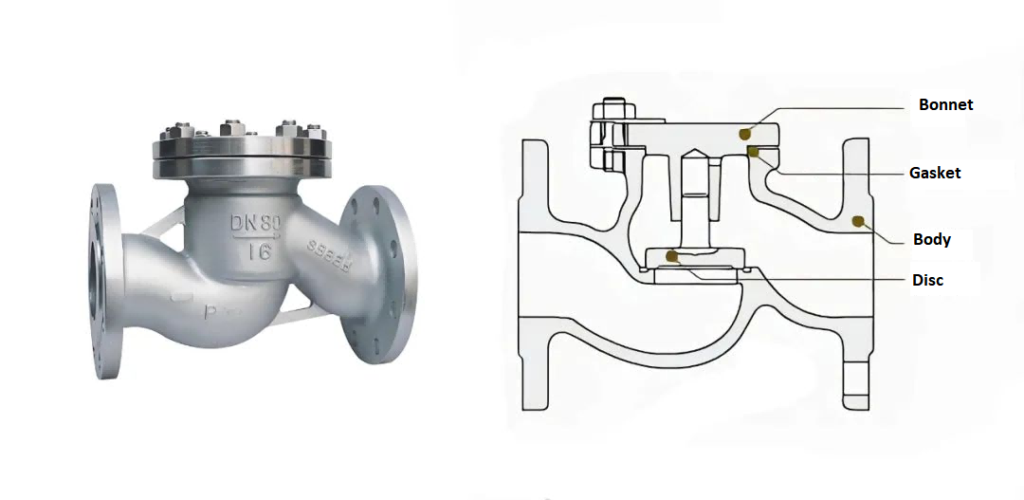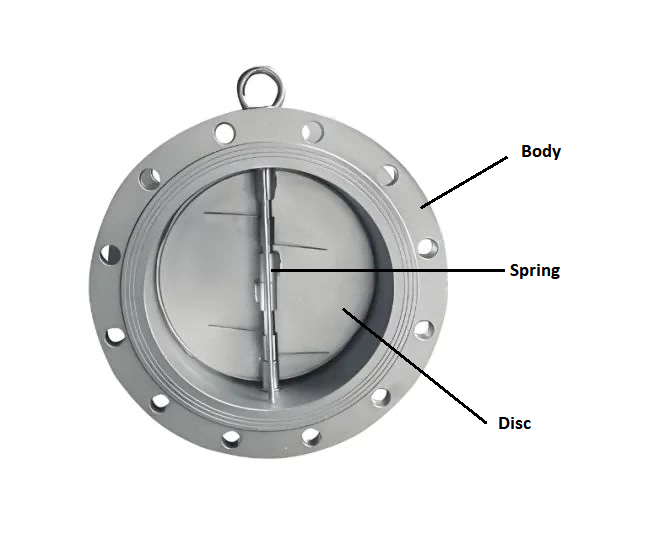Check valve refers to a valve with a circular disc as the opening and closing part, which blocks the backflow of the medium by its own weight and the pressure of the medium. It belongs to the automatic valve category, also known as non-return valve, one-way valve, reflux valve or isolation valve. Check valve is often used as a bottom valve of a pumping device to prevent the backflow of water. Check valve and stop valve are used in combination to play a role of safety isolation.
Working Principle
The working principle of the check valve is to rely on the weight of the opening and closing parts (valve disc) and the medium pressure to achieve automatic opening and closing, thereby preventing the medium from flowing back. When the medium flows in from the inlet end and flows out from the outlet end, the valve disc opens under the action of the medium pressure. When the inlet pressure is less than the sum of the valve disc weight and its flow resistance, the valve closes to prevent the medium from flowing back.
Valve Types
The check valve is mainly classified according to the movement form of the valve disc, which can be specifically divided into the following types:
Lift check valve
Features: The valve disc moves up and down along the axis perpendicular to the center line of the valve body.
Classification:
Vertical lift check valve: The valve disc moves up and down along the center line of the valve body.
Horizontal lift check valve: The valve disc moves up and down along the axis parallel to the center line of the valve body.
Working principle: When the medium flows in from the inlet end, the valve disc is pushed open under the action of the medium pressure, and the medium can flow; when the medium flows back, the valve disc is closed under the dual action of its own weight and the pressure of the backflow medium to prevent the medium from flowing back.
Advantages:
- Simple structure: It is composed of valve body, valve disc, valve seat and spring, which is easy to manufacture and maintain.
- Wide application range: It can be used for a variety of fluid media and temperatures.
- Quick opening and closing: Good sealing performance, small resistance when fluid passes through.
- Easy installation: It can be used in horizontal or vertical pipelines.
Disadvantages:
- Loud noise: The valve disc needs to overcome the resistance of the spring during the opening and closing process, which may produce loud noise.
- Fragile spring: The spring is easily corroded and worn by the medium, which affects the service life.

Swing check valve
Features: The valve disc rotates around the pin outside the valve seat.
Classification:
Single-flap swing check valve: only one valve disc, suitable for pipes with smaller diameters.
Double-flap swing check valve: two valve discs, suitable for pipes with larger diameters.
Multi-flap swing check valve: multiple valve discs, suitable for pipes with even larger diameters.
Working principle: When the medium flows in from the inlet end, the valve disc rotates around the pin under the action of the medium pressure to open, and the medium can flow; when the medium flows back, the valve disc rotates around the pin under the action of the backflow medium pressure and its own weight to close, preventing the medium from flowing back.
Advantages:
- Small fluid resistance: strong flow capacity, suitable for high viscosity and solid particle-containing fluids.
- Low noise: relatively low noise during opening and closing.
- Smooth opening and closing: the valve disc rotates around the valve seat axis to achieve opening and closing, and the process is smooth.
Disadvantages:
- Complex structure: compared with the lifting check valve, the structure is more complex and the manufacturing cost is higher.
- High installation requirements: it is necessary to ensure that the valve disc can rotate smoothly, and the requirements for the installation position are high.

Butterfly / Dual Plate Check Valve
Features: The valve disc is disc-shaped and rotates around the center axis of the valve seat.
Classification:
Dual plate wafer check valve: The valve has two disc-shaped plates that pivot on a hinge or pin. These plates open and close in response to fluid flow.
Single plate wafer check valve: It has a single disc that pivots on a hinge or pin to allow or block the flow of fluid.
Wafer type lift check valve: Features a single disc or “lift” that moves vertically (up and down) to control the flow of fluid. The valve is designed to fit between two flanges, making it compact and minimizing the space required for installation.
Working principle: When the medium flows in from the inlet, the valve disc rotates around the center axis under the action of the medium pressure to open, allowing the medium to flow; when the medium flows back, the valve disc rotates around the center axis under the action of the backflow medium pressure and its own weight to close, preventing the medium from flowing back.
Advantages:
- Compact structure: small fluid resistance, suitable for large-diameter pipes.
- Easy installation and maintenance: simple structure, relatively easy installation and maintenance.
- Rapid opening and closing: good sealing performance, rapid opening and closing.
Disadvantages:
- The noise may be large: since the valve disc needs to rotate a large angle during the opening and closing process, a certain amount of noise may be generated.
- High installation requirements: It is necessary to ensure that the valve disc can rotate smoothly, and the requirements for the installation position are high.

Different types of check valves have their own advantages and disadvantages. When selecting a check valve, you need to comprehensively consider factors such as the actual application scenario, fluid characteristics, and pipeline conditions to ensure that you choose the most suitable check valve type. At the same time, the installation and maintenance of the check valve must also be carried out in accordance with relevant specifications to ensure its normal operation and service life.
Notes
During the installation and use of the check valve, the following matters need to be noted to ensure its normal operation and extend its service life:
Installation precautions
- Directionality: When installing a check valve, it is important to note that the direction of the medium flow should be consistent with the direction of the arrow marked on the valve body to ensure that the check valve can normally prevent the medium from flowing back.
- Pipeline support: In the pipeline system, do not let the check valve bear weight. Large check valves should be supported independently so that they are not affected by the pressure generated by the pipeline system.
- Vertical and horizontal installation: Lift-type vertical flap check valves should be installed on vertical pipelines, while lift-type horizontal flap check valves should be installed on horizontal pipelines.
- Avoid direct connection: A telescopic tube should be used between the wafer check valve and the butterfly valve to avoid direct connection with other valves to reduce potential damage to the check valve.
- Space reservation: When installing a wafer check valve at the outlet of the water pump, a space of at least six times the valve diameter should be left to ensure that the butterfly plate is eventually affected by the fluid.
Precautions for use and maintenance
- Backflow is prohibited: The check valve should be installed on the pipeline of the flowing medium to ensure that the fluid can only flow in one direction and backflow is prohibited. If backflow may occur, other measures should be taken, such as installing a two-way check valve.
- Inverted installation is prohibited: The check valve should be installed correctly according to the installation mark or the arrow direction indicated on the instruction manual, and inverted installation is prohibited. Inverted installation will cause the check valve to fail to function normally.
- Avoid over-tightening: During the installation process, the check valve or pipe connector should not be over-tightened to avoid damage to the valve body and sealing surface.
- Select suitable sealing materials: When selecting sealing materials, suitable materials should be selected according to the properties of the fluid and working conditions. It is prohibited to use sealing materials that are incompatible with the fluid to avoid leakage or corrosion.
- Avoid high temperature and high pressure operation: Under high temperature and high pressure conditions, the pressure in the pipeline should be gradually released first, and the check valve should be opened after the pressure drops to a safe range to avoid danger.
- Avoid cutting or welding: During installation and maintenance, avoid cutting or welding on the installed check valve to avoid damaging the valve body and sealing surface and affecting normal use.
- Pay attention to flow restrictions: According to the rated flow of the check valve, the appropriate valve size and pipe size should be selected. The flow rate exceeding the rated flow of the check valve is prohibited to avoid affecting the valve performance and life.
Following the above precautions can ensure the normal operation of the check valve and extend its service life.



